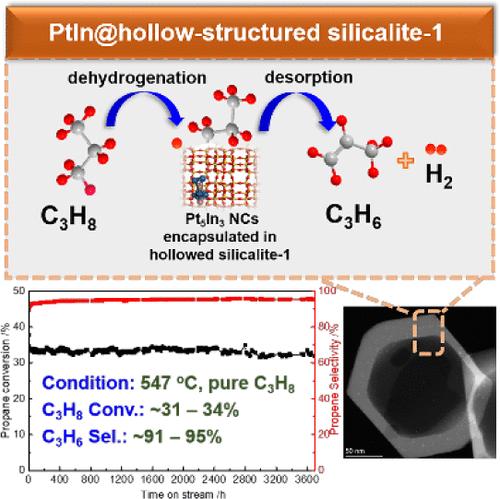当前位置:
X-MOL 学术
›
ACS Catal.
›
论文详情
Our official English website, www.x-mol.net, welcomes your
feedback! (Note: you will need to create a separate account there.)
Efficient Dehydrogenation of Propane to Propene over PtIn Nanoclusters Encapsulated in Hollow-Structured Silicalite-1
ACS Catalysis ( IF 11.3 ) Pub Date : 2024-11-18 , DOI: 10.1021/acscatal.4c05135 Shiying Li, Qi Li, Baichao Li, Xiao Chen, Hongbin Wu, Sen Wang, Mei Dong, Jianguo Wang, Weibin Fan
ACS Catalysis ( IF 11.3 ) Pub Date : 2024-11-18 , DOI: 10.1021/acscatal.4c05135 Shiying Li, Qi Li, Baichao Li, Xiao Chen, Hongbin Wu, Sen Wang, Mei Dong, Jianguo Wang, Weibin Fan

|
Pt-based catalysts have been widely used for propane dehydrogenation to propene. However, the high reaction temperature generally induces serious sintering and agglomeration of metal species, thus leading to rapid deactivation of the catalysts. Herein, PtIn nanoclusters (NCs) encapsulated in hollow-structured silicalite-1 (designated as PtIn@S1–H) was prepared using recrystallization method. This material shows high catalytic performance in propane dehydrogenation. The propane conversion and propene selectivity reach ∼45–47.5% and ∼99%, respectively, at 547 °C at least within 167.6 h. As a result, it displays a significantly higher specific activity for C3H6 formation (0.37–0.59 s–1) than Pt@S1, Pt@S1–H, and other reported Pt-based catalysts. Notably, its catalytic performance is well maintained for more than 3600 h, with propane conversion of ∼31–34% and propene selectivity of ∼91–95%, when pure propane is fed. More interestingly, this catalyst can be reused through regeneration. EXAFS, HAADF-STEM and DFT calculation, and AIMD simulation results show that hollow-structured silicalite-1 crystal morphology not only facilitates the formation of Pt5In3 alloy NCs but also inhibits NC aggregation and growth. PtIn@S1–H showed a TON ≥ 38996 in contrast to 5367, 4928, 798, and 542 obtained on PtIn@S1, PtSn@S1, PtSn/Al2O3, and PtIn/Al2O3, respectively, if the catalysts were considered to be deactivated when the propane conversion was decreased by 15%. This is because alloying of In into Pt NCs weakens the interaction of C3H7* intermediates with metallic Pt NCs and the adsorption of C3H6 on the catalyst surface, thus suppressing the C3H7* cleavage reaction and enhancing propane activation and propene selectivity.
中文翻译:

在封装在空心结构硅石-1 中的 PtIn 纳米团簇上丙烷高效脱氢制丙烯
铂基催化剂已广泛用于丙烷脱氢制丙烯。然而,高反应温度通常会诱导金属种类的严重烧结和团聚,从而导致催化剂的快速失活。在此,使用重结晶法制备了封装在中空结构硅石-1 (指定为 PtIn@S1-H) 中的 PtIn 纳米团簇 (NCs)。这种材料在丙烷脱氢中表现出很高的催化性能。丙烷转化率和丙烯选择性在 547 °C 下至少在 167.6 小时内分别达到 ∼45-47.5% 和 ∼99%。因此,它对 C3H6 形成的比活性 (0.37–0.59 s–1) 明显高于 Pt@S1、Pt@S1–H 和其他已报道的基于 Pt 的催化剂。值得注意的是,当进料纯丙烷时,其催化性能保持良好超过 3600 小时,丙烷转化率约为 31-34%,丙烯选择性为 ∼91-95%。更有趣的是,这种催化剂可以通过再生来重复使用。EXAFS、HAADF-STEM 和 DFT 计算以及 AIMD 模拟结果表明,中空结构硅石-1 晶体形貌不仅促进了 Pt5In3 合金 NCs 的形成,还抑制了 NC 的聚集和生长。PtIn@S1-H 的吨≥ 38996,而 PtIn@S1、PtSn@S1、PtSn/Al2O3 和 PtIn/Al2O3 分别获得 5367、4928、798 和 542 吨,如果认为当丙烷转化率降低 15% 时催化剂已失活。 这是因为 In 合金化成 Pt NCs 削弱了 C3H7* 中间体与金属 Pt NCs 的相互作用以及 C3H6 在催化剂表面的吸附,从而抑制了 C3H7* 裂解反应,增强了丙烷活化和丙烯选择性。
更新日期:2024-11-18
中文翻译:

在封装在空心结构硅石-1 中的 PtIn 纳米团簇上丙烷高效脱氢制丙烯
铂基催化剂已广泛用于丙烷脱氢制丙烯。然而,高反应温度通常会诱导金属种类的严重烧结和团聚,从而导致催化剂的快速失活。在此,使用重结晶法制备了封装在中空结构硅石-1 (指定为 PtIn@S1-H) 中的 PtIn 纳米团簇 (NCs)。这种材料在丙烷脱氢中表现出很高的催化性能。丙烷转化率和丙烯选择性在 547 °C 下至少在 167.6 小时内分别达到 ∼45-47.5% 和 ∼99%。因此,它对 C3H6 形成的比活性 (0.37–0.59 s–1) 明显高于 Pt@S1、Pt@S1–H 和其他已报道的基于 Pt 的催化剂。值得注意的是,当进料纯丙烷时,其催化性能保持良好超过 3600 小时,丙烷转化率约为 31-34%,丙烯选择性为 ∼91-95%。更有趣的是,这种催化剂可以通过再生来重复使用。EXAFS、HAADF-STEM 和 DFT 计算以及 AIMD 模拟结果表明,中空结构硅石-1 晶体形貌不仅促进了 Pt5In3 合金 NCs 的形成,还抑制了 NC 的聚集和生长。PtIn@S1-H 的吨≥ 38996,而 PtIn@S1、PtSn@S1、PtSn/Al2O3 和 PtIn/Al2O3 分别获得 5367、4928、798 和 542 吨,如果认为当丙烷转化率降低 15% 时催化剂已失活。 这是因为 In 合金化成 Pt NCs 削弱了 C3H7* 中间体与金属 Pt NCs 的相互作用以及 C3H6 在催化剂表面的吸附,从而抑制了 C3H7* 裂解反应,增强了丙烷活化和丙烯选择性。

































 京公网安备 11010802027423号
京公网安备 11010802027423号